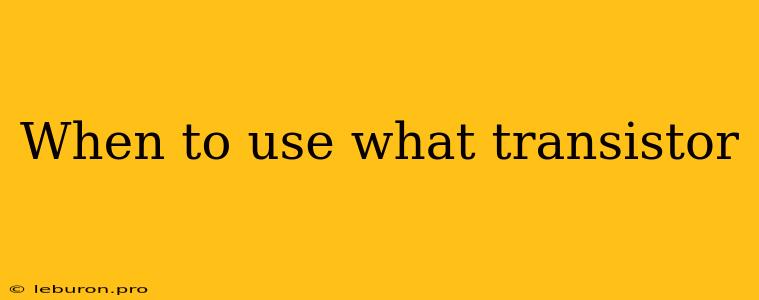Choosing the right transistor for a specific application can be a daunting task, considering the vast array of options available. Transistors are essential components in countless electronic circuits, acting as electronic switches or amplifiers. Understanding their characteristics and limitations is crucial for selecting the best transistor for your project. This article will delve into the factors to consider when deciding when to use what transistor, focusing on the most commonly used types: bipolar junction transistors (BJTs) and field-effect transistors (FETs).
Understanding Transistor Types and Their Characteristics
Transistors are semiconductor devices that control the flow of current between two terminals, often referred to as the collector and emitter. The third terminal, known as the base in BJTs and gate in FETs, acts as a control element.
Bipolar Junction Transistors (BJTs)
BJTs are current-controlled devices, meaning the current flowing through the base terminal controls the current flowing between the collector and emitter. They are typically made of silicon and come in two configurations: NPN and PNP.
Key Characteristics of BJTs:
- High current gain: BJTs can amplify a small base current into a larger collector current.
- Lower input impedance: Compared to FETs, BJTs have lower input impedance, meaning they draw more current at their base terminal.
- Lower switching speed: BJTs typically exhibit slower switching speeds compared to FETs.
- Susceptibility to thermal runaway: Due to their current-controlled nature, BJTs can be prone to thermal runaway if not properly designed and controlled.
Field-Effect Transistors (FETs)
FETs, on the other hand, are voltage-controlled devices. The voltage applied to the gate terminal controls the current flowing between the drain and source terminals. FETs come in various types, including junction FETs (JFETs) and metal-oxide-semiconductor field-effect transistors (MOSFETs).
Key Characteristics of FETs:
- High input impedance: FETs offer high input impedance, meaning they draw minimal current at their gate terminal.
- Faster switching speed: FETs generally have faster switching speeds than BJTs.
- Lower power consumption: Due to their voltage-controlled nature, FETs consume less power compared to BJTs.
- Wide range of applications: FETs are suitable for various applications, including analog switching, amplification, and digital logic circuits.
Factors to Consider When Choosing a Transistor
When deciding when to use what transistor, consider the following factors:
1. Application Requirements
- Switching speed: For applications requiring fast switching times, such as high-frequency oscillators or digital circuits, FETs are preferred.
- Current gain: BJTs are well-suited for applications requiring high current gain, like power amplifiers.
- Input impedance: If the circuit demands a high input impedance, FETs are the better choice.
- Power consumption: For applications where low power consumption is crucial, FETs are favored.
- Operating voltage: The maximum operating voltage of the transistor should be compatible with the circuit voltage.
- Operating current: The maximum current handling capability of the transistor should exceed the circuit current requirements.
2. Operating Conditions
- Temperature: Consider the operating temperature range of the transistor and ensure it can withstand the expected environmental conditions.
- Humidity: If the circuit operates in a humid environment, select transistors with appropriate moisture resistance.
- Vibration and shock: For applications subject to vibration or shock, consider transistors with robust construction.
3. Cost and Availability
- Cost: The cost of transistors can vary significantly. Choose a transistor that meets the application requirements while remaining within budget.
- Availability: Ensure the chosen transistor is readily available from reputable suppliers.
Specific Examples of When to Use What Transistor
Here are some specific examples of when to use different types of transistors:
- High-frequency amplifiers: FETs are preferred due to their high switching speed and low input capacitance.
- Power amplifiers: BJTs are commonly used due to their high current gain.
- Digital logic circuits: MOSFETs are often employed because of their fast switching speed and ease of integration.
- Low-power applications: FETs are preferred for their low power consumption.
- Analog switching: JFETs are suitable for their high input impedance and low on-resistance.
Conclusion
Choosing the right transistor involves careful consideration of application requirements, operating conditions, cost, and availability. By understanding the characteristics and limitations of each type, you can make informed decisions about when to use what transistor, ensuring optimal performance and reliability in your electronic circuits. This understanding will enhance your ability to design and build efficient and effective electronic systems.
